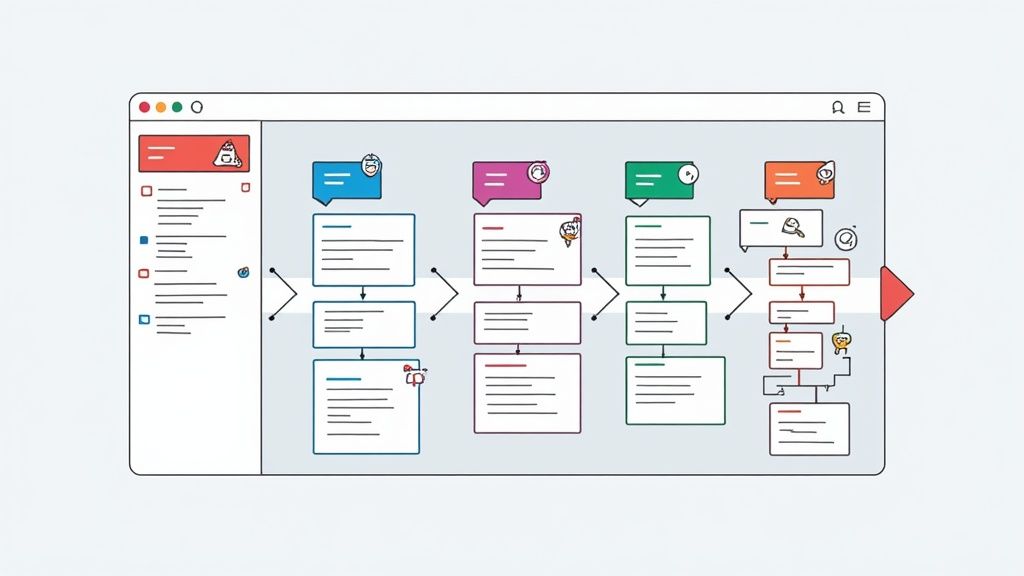Project Management Website Development: Winning Blueprint
- shems sheikh
- 2 days ago
- 13 min read
The Strategic Foundation of Website Development Projects

Building a website is a lot like constructing a building. A solid blueprint and a skilled project manager are essential. Without them, the process can quickly become disorganized and expensive. This is where project management in website development becomes crucial. It provides the essential structure needed to bring a website from initial concept to a fully realized online presence. Think of it as the backbone of the entire development lifecycle.
For instance, imagine developing a complex website packed with features like e-commerce functionality, user forums, and a blog. Each element demands careful planning and execution. Project management helps by breaking down these complex tasks into smaller, manageable steps. This methodical approach ensures that every single aspect of the website receives the attention it deserves, minimizing the risk of overlooking critical details.
Defining Project Scope and Objectives
One of the first steps in managing a website development project is defining the project scope. This involves outlining the website's specific goals, identifying the target audience, and determining the functionalities needed. Think of it like an architect deciding the purpose of a building. Is it a residential house, a commercial office, or a retail space? Each purpose demands a unique design and a specific set of features. You might find this resource helpful: How to master sitemapping.
Clearly defining objectives is also essential. What exactly do you want your website to achieve? Are you aiming for increased sales, lead generation, greater brand awareness, or perhaps a combination of these? These objectives serve as the project's roadmap, providing crucial direction. This initial clarity sets the stage for a successful development process. Well-defined goals also allow the team to accurately measure progress along the way.
Choosing the Right Methodology
After defining the scope, the next step involves selecting the appropriate project management methodology. Several methodologies exist, including Agile, Waterfall, and Kanban. The best choice depends on the specific project requirements and the team's structure. Agile, for example, is known for its flexibility and iterative approach, while Waterfall follows a more linear, sequential process.
This decision significantly impacts how the project is managed, from task allocation to communication flow. The chosen methodology becomes the foundation of the development process. This structured framework ensures smooth and organized project execution. Moreover, the right methodology can significantly enhance team collaboration and communication.
The Growing Importance of Project Management Software
The use of project management software is becoming increasingly critical in modern web development. The global online project management software market, valued at approximately $5.6 billion in 2023, is projected to reach about $11.4 billion by 2032, growing at a CAGR of 8.4%. Find more detailed statistics here. This impressive growth highlights the growing recognition of the value of project management tools in boosting efficiency and achieving successful project outcomes. These tools allow for better progress tracking, resource allocation, and communication, leading to streamlined workflows. This, in turn, results in websites being delivered on time and within budget.
Selecting Tools That Transform Your Web Development Workflow

Building a strong website starts with a solid strategy. But equally important are the tools you use to bring that strategy to life. These tools empower your team to execute plans effectively. Choosing the right tools means thinking about your current needs and anticipating what you'll need as your projects grow. Just like any craftsman, using the right tools for the job drastically improves efficiency and results.
Planning and Communication Tools: The Cornerstones of Collaboration
Successful website development relies heavily on clear communication and thorough planning. Selecting the right platforms is crucial for this. Consider various options, including dedicated project management tools, which are discussed in more detail on the Upvoty blog.
Tools like Asana and Trello offer visual task management with Kanban boards, allowing teams to see project progress. Assigning tasks, setting deadlines, and tracking progress all happen in a shared digital space. Real-time communication platforms like Slack keep discussions flowing and minimize email overload, leading to faster problem-solving. These tools become the central hub of your project, keeping everyone informed and connected.
Version Control and Design Collaboration: Ensuring Consistency and Quality
As websites become more complex and teams grow, managing versions and design collaboration becomes critical. Git, a distributed version control system, allows developers to track code changes, work together on updates, and easily revert to earlier versions. This maintains code integrity and prevents small errors from becoming big problems.
Design collaboration tools like Figma and Adobe XD allow designers to work together on website visuals, share prototypes, and collect feedback in one place. Teams can edit mockups simultaneously, ensuring consistent branding and a smooth user experience. This speeds up the design process and reduces inconsistencies.
Building a Tech Stack That Fits Your Needs
Choosing the right tools isn’t about chasing the latest trends. It's about building a tech stack that matches your specific project needs. Consider factors like project complexity, your team's structure, and your budget. A small team working on a basic website might be fine with free tools. A larger agency handling complex e-commerce projects will likely need more robust, integrated solutions.
A custom tech stack maximizes efficiency by ensuring your tools work together smoothly. For example, integrating your project management software with your communication platform automates updates between systems. This saves time and reduces manual effort, creating a streamlined workflow that lets your team focus on development.
To help illustrate how different tools can fit diverse needs, let's look at some popular options:
Top Project Management Tools for Website Development: Comparison of leading project management platforms with features specific to website development
Tool Name | Best For | Key Features | Price Range | Integration Capabilities |
|---|---|---|---|---|
Asana | Teams of all sizes | Kanban boards, task management, project timelines | Free - $24.99/user/month | Wide range of integrations including Slack, Google Calendar, Microsoft Teams |
Trello | Small to medium-sized teams, visual project management | Kanban boards, simple interface, easy collaboration | Free - $17.50/user/month | Integrations with tools like Slack, Google Drive, and Jira |
Jira | Software development teams | Agile project management, bug tracking, issue tracking | Free - $16.75/user/month | Integrates with development tools like Bitbucket, GitHub, and Confluence |
Monday.com | Visual project management, marketing teams | Customizable workflows, Kanban boards, dashboards | Free - $16/user/month | Integrations with various tools including Slack, Google Calendar, and Mailchimp |
ClickUp | All-in-one project management | Task management, document collaboration, time tracking | Free - $19/user/month | Numerous integrations including Slack, Google Drive, and GitHub |
This table highlights some key differences and similarities between these tools. Selecting the right tool will depend on your team's size, budget, and required features.
Choosing the right tools is a crucial step in streamlining your web development workflow.
Maximizing ROI on Your Technology Investments
Investing in the right tools can significantly improve the efficiency and quality of your web development projects. But maximizing your return on investment (ROI) requires more than just buying software. It requires strategic implementation and ongoing evaluation.
Provide adequate training so your team can use all the features effectively. Regularly monitor tool usage to identify areas for improvement and spot any redundant functionalities. For example, if your team only uses 20% of a tool’s capabilities, it might be time for more training or a different tool. This ongoing assessment ensures you get the most value from your investment and continuously optimize your workflow. This proactive approach turns project management tools into strategic assets that drive project success.
Mastering the Critical Phases of Website Project Delivery

A well-structured approach to website project delivery is essential for success. This involves understanding and mastering each phase of the project lifecycle. A structured approach minimizes revisions and keeps the project on schedule, ensuring the final product meets the client's needs and expectations.
Discovery and Planning: Laying the Groundwork
The initial Discovery and Planning phase involves gathering requirements, defining the project scope, and setting clear objectives. This crucial stage establishes a shared understanding between the development team and the client, allowing for early identification of potential challenges. Just like an architect drafts blueprints before construction, thorough discovery sets the stage for project success.
Planning involves breaking the project into smaller, manageable tasks. Deadlines are established, resources are allocated, and a detailed project roadmap is created. This roadmap, outlining task sequences and dependencies, guides the entire project lifecycle, ensuring everyone works towards a shared goal.
Design and Development: Bringing the Vision to Life
The Design phase translates the project vision into concrete visuals. This involves creating wireframes, mockups, and prototypes, which act as blueprints for the developers. This collaborative process ensures the final design meets both the client's aesthetic preferences and the project’s functionality. For increased team efficiency, consider streamlining creative workflow management.
The Development phase brings the approved design to life through coding and technical implementation. This stage requires close collaboration between developers, designers, and project managers. Regular communication and progress updates are key to keeping development aligned with design specs and the project timeline.
Testing and Launch: Ensuring Quality and Deployment
Thorough Testing is crucial before website launch. This phase includes functionality testing, usability testing, and performance testing. Identifying and addressing bugs early ensures a smooth user experience after launch. This proactive quality assurance minimizes post-launch fixes.
The Launch phase involves deploying the website to the live server. Careful planning and execution minimize downtime and ensure a seamless transition. Post-launch, ongoing monitoring and maintenance are vital for optimal performance and security. For further insights, explore how to master dynamic use cases.
Managing Transitions and Maintaining Alignment
Effective project management requires clear transition points between each phase. These transitions ensure each phase meets the required standards before proceeding. This structured approach minimizes errors, rework, and helps maintain project momentum and schedule adherence.
Despite advancements in project management tools, IT project success rates remain a challenge. Studies show only 59% of IT projects finish within budget, 47% on time, and 44% deliver the intended benefits. Shockingly, only 1 in 200 IT projects meet all three metrics. For more detailed statistics, see this resource. This underscores the vital importance of robust project management practices.
Maintaining stakeholder alignment is paramount throughout the project. Regular communication, progress reports, and feedback sessions keep everyone informed and engaged. This transparency builds trust and ensures project alignment with client goals. A continuous feedback loop allows for adjustments, increasing the likelihood of project success. Adapting these frameworks to various project methodologies while protecting scope, timeline, and budget, even amidst mid-project challenges, is a hallmark of experienced project managers. This adaptability and resilience are crucial for navigating the complexities of website development projects.
Building High-Performance Website Development Teams

Effective website development hinges on the team behind it. A high-performing team can mean the difference between a successful launch and a missed deadline. This section explores building and managing a team that consistently delivers exceptional results, focusing not just on technical skills, but also team dynamics.
Team Structures for Different Project Types
Different projects demand different team structures. A small website redesign might need a few people, while a large e-commerce platform requires a bigger team.
For smaller projects, a project manager overseeing designers and developers can be effective. Larger projects benefit from a more structured approach with specialized teams. Think front-end development, back-end development, and UX/UI design. This specialization boosts efficiency and expertise.
Communication Protocols: Bridging the Gap
Clear communication is crucial in website development. Miscommunication can lead to inconsistencies and errors. Establishing clear protocols is key.
Daily stand-up meetings
Visual feedback tools like Beep
Beep allows direct feedback on live websites, simplifying communication with screenshots and annotations. This fosters collaboration and reduces misunderstandings.
Conflict Resolution and Productive Collaboration
Conflict is unavoidable. Unresolved conflict, however, can derail projects and lower morale. Conflict resolution strategies are essential.
Open communication
Active listening
A framework for addressing disagreements
Turning conflict into productive collaboration strengthens team dynamics and improves project outcomes. This builds a culture of respect and collaboration.
Managing Distributed Development Teams and Skill Development
With the rise of remote work, many teams are geographically dispersed. Managing these teams presents unique challenges. Tools like Slack for instant communication and platforms like Beep for centralized feedback and task management are essential. This creates a virtual workspace.
Ongoing skill development increases team capability and adaptability to new technologies and project requirements. Investing in team growth contributes to long-term success.
Accountability and Creativity: Finding the Balance
Accountability keeps projects on track, but it shouldn't stifle creativity. Clearly defined roles and responsibilities, along with regular progress check-ins, create ownership without being overly restrictive.
This balance creates a productive environment where team members feel empowered. This leads to improved quality and increased productivity, ultimately impacting the success of any web project.
Financial Management That Protects Website Project Success
Building a website is like constructing a house. A solid foundation is crucial. For websites, that foundation is robust financial management. Budget overruns can quickly derail even the most promising projects. This section provides a framework for managing finances specifically designed for website development.
Accurate Estimation Techniques for Website Components
Accurate cost estimation is your first defense against budget overruns. Different website components require different estimation strategies. Designing a custom e-commerce platform, for example, needs more resources (and a bigger budget) than a simple landing page.
Breaking down the project into smaller parts allows for more precise cost estimates. It's like itemizing the costs of building a house: foundations, walls, roofing, plumbing, electrical, and so on. This granular approach leads to a more accurate overall budget.
Identifying Hidden Costs in Website Development
Hidden costs can sneak up on project teams and wreck carefully planned budgets. These might include software licenses, server costs, ongoing maintenance, and unexpected technical hurdles.
Imagine your project requires integration with a third-party API. If the API's documentation is poor or the integration more complex than expected, you'll face unforeseen development time and costs. Proactively identifying these potential problems is key.
Maintaining Budget Control Throughout Project Execution
Maintaining budget control requires constant attention and proactive adjustments. Think of it like steering a ship. You need to adjust course based on weather and currents. Similarly, project budgets need adjusting based on new challenges and changing requirements.
Tools like project management dashboards and regular cost tracking provide real-time insight into budget performance, allowing for timely adjustments and preventing costly surprises.
Contingency Planning and Resource Allocation
Unexpected issues always pop up in website development. A realistic contingency plan is your safety net. Setting aside 10-20% of the budget for unforeseen problems prevents minor setbacks from becoming major financial crises.
Resource allocation is another key element. Prioritizing features within budget constraints often means tough decisions about what's essential and what can be postponed or scaled back.
You might be interested in: How to master dynamic alternatives.
Vendor Management and Stakeholder Communication
Many website projects involve outside vendors for design, content creation, or specialized development. Effective vendor management is essential to control costs without sacrificing quality. This means clear contracts, well-defined deliverables, and regular communication.
Communicating budget realities to stakeholders is also crucial. Transparency about potential risks and challenges builds trust and allows for informed decisions. Open communication helps manage expectations and avoids unpleasant surprises. Using platforms like Beep for visual feedback can streamline these conversations.
To illustrate the potential cost distribution and hidden costs associated with website development, consider the following table:
Website Development Cost Breakdown: Typical cost allocation across different components of website development projects
Project Component | Percentage of Budget | Common Cost Range | Potential Hidden Costs |
|---|---|---|---|
Planning & Discovery | 10-15% | $500 - $2,000 | Stakeholder misalignment, scope creep |
Design | 15-20% | $750 - $3,000 | Revision requests, complex animations |
Development | 40-50% | $2,000 - $5,000 | Unexpected technical challenges, third-party API integration complexities |
Testing & QA | 10-15% | $500 - $2,000 | Cross-browser compatibility issues, performance optimization |
Launch & Deployment | 5-10% | $250 - $1,000 | Server setup, security hardening |
This table offers a general guide. Actual costs will vary based on project requirements. Keeping these potential hidden costs in mind allows for more accurate budgeting and fewer financial surprises.
Anticipating and Neutralizing Website Project Risks
Building a website is a lot like constructing a building. There are numerous risks that can lead to delays, budget blowouts, and even total project failure. The best project managers understand this and work proactively to identify and mitigate these risks before they become major problems. This means understanding the specific challenges of website development and having strategies in place to deal with them.
Common Website Development Project Risks
Several key risks frequently pop up in website projects. Scope creep, or scope expansion, happens when the project requirements grow beyond the initial agreement. This can be due to unclear specifications at the start or evolving client needs. Technical debt is another common issue. It builds up when developers prioritize speed over code quality, creating future maintenance headaches.
Compatibility issues across different browsers and devices also present a challenge. Ensuring a consistent user experience requires thorough testing. Website security is another major concern. Security vulnerabilities make sites attractive targets for hackers, and neglecting security can lead to data breaches and damage your reputation. Finally, performance bottlenecks, like slow loading times, can frustrate users and hurt your search engine rankings.
Risk Identification and Evaluation
Effective risk management begins with identifying potential problems. Brainstorm with your project team, stakeholders, and even clients. Looking back at past projects can also offer valuable insights into recurring issues. Once identified, assess each risk based on its likelihood and potential impact. A simple risk matrix can help visualize and prioritize these factors. A high likelihood, high impact risk needs immediate action.
Mitigation Strategies and Monitoring
After identifying and evaluating risks, create mitigation strategies. For scope creep, establish clear communication and change management processes. Addressing technical debt means prioritizing code quality and doing regular code reviews.
Compatibility problems require rigorous cross-browser and cross-device testing. Implement strong security practices, including penetration testing and regular security audits. To tackle performance bottlenecks, use optimization techniques like image compression and efficient caching. Finally, set up monitoring systems that track important metrics, like website traffic and error rates, to provide early warnings of potential issues.
Governance and Balancing Risk with Momentum
Clear governance structures are essential for effective risk management. This involves defining roles and responsibilities for risk mitigation and creating reporting procedures. However, it's important to balance risk management with project momentum. Too much bureaucracy can stifle creativity and slow development. Aim for just enough structure to manage risks effectively without creating roadblocks. Think of it like guardrails on a winding road—they provide protection without hindering forward movement. This balanced approach allows teams to address risks proactively while staying flexible and adaptable to changing project needs. Using tools like Beep for visual communication can help streamline these processes and keep projects on track, delivering quality results while minimizing potential disruptions.
Measuring What Matters in Website Development Projects
Successfully managing a website development project involves more than just meeting deadlines and budgets. It's about understanding what truly defines success for the project and using metrics that reflect these goals. This means going beyond basic project management benchmarks and looking at the bigger picture – how the website performs technically, the user experience, and its contribution to overall business objectives.
Establishing Meaningful Metrics
Defining "success" is the first step. This requires working closely with stakeholders to identify Key Performance Indicators (KPIs) aligned with business goals. For an e-commerce site, KPIs might include conversion rates and average order value. For a blog, key metrics could be page views, bounce rate, and social shares. This clear definition of success sets the stage for accurate measurement and valuable analysis.
Technical Performance Indicators
Technical performance is crucial for user experience and search engine rankings. Page load speed, uptime, and mobile responsiveness are essential. A slow site can frustrate users and increase bounce rates. This highlights the importance of tracking and optimizing technical aspects.
User Experience Measurements
User experience focuses on how easy and enjoyable the website is to use. Metrics like time on page, navigation flow, and task completion rate offer insights into user behavior. Tools like Hotjar heatmaps can visually represent user interactions, highlighting areas for improvement in design and navigation.
Business Impact Assessments
Measuring business impact demonstrates ROI. This might involve tracking lead generation, sales conversions, and customer acquisition cost. If a website aims to generate leads, tracking form submissions and conversions shows its effectiveness.
Project Efficiency Benchmarks
Besides website performance, assessing project efficiency is important. This involves tracking metrics like time to completion, budget adherence, and resource utilization. This information helps improve project management processes.
Implementing Measurement Frameworks and Presenting Data
A robust measurement framework captures both quantitative data (like website traffic) and qualitative feedback (like user surveys). This provides a complete view of project health.
Presenting data to stakeholders requires clear communication. Dashboards, reports, and visuals can effectively communicate complex information. Regular communication keeps stakeholders informed and aligned with project goals.
Leveraging Metrics for Continuous Improvement
Success metrics should drive continuous improvement. Regularly analyzing data and feedback identifies areas for website optimization, process refinement, and stakeholder alignment. This ongoing evaluation is crucial for long-term success. When stakeholders have different views on success, open discussion and finding common ground are key. Building consensus ensures everyone works towards a shared vision.
Beep, the feedback and collaboration platform, streamlines this process by facilitating clear communication and simplifying feedback collection. Learn more about how Beep can help your website projects: Beep.

.png)
Comments